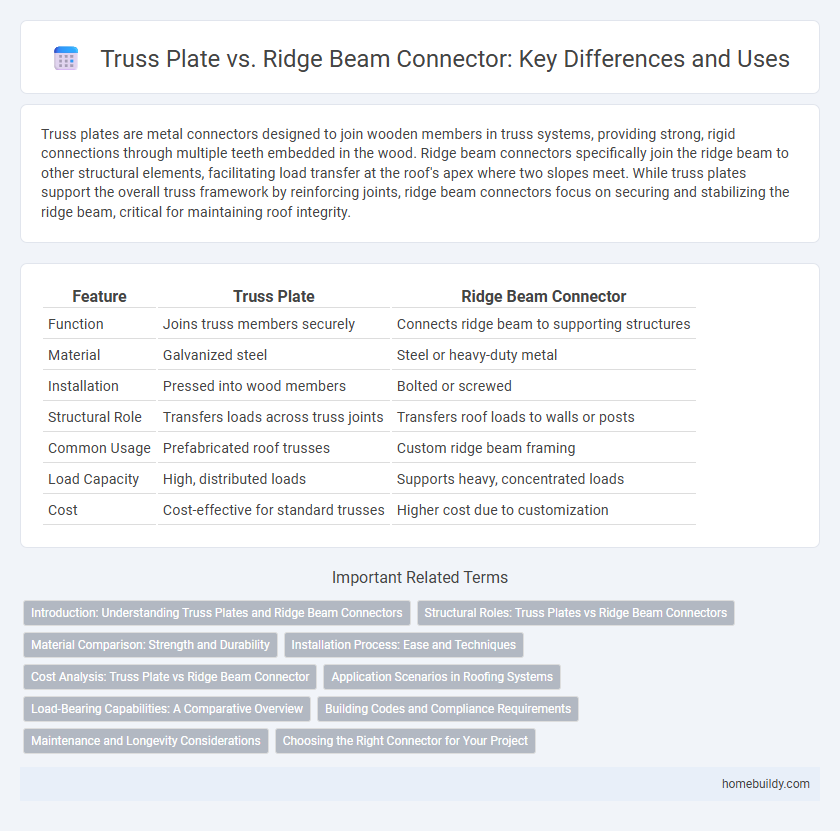Truss plates are metal connectors designed to join wooden members in truss systems, providing strong, rigid connections through multiple teeth embedded in the wood. Ridge beam connectors specifically join the ridge beam to other structural elements, facilitating load transfer at the roof's apex where two slopes meet. While truss plates support the overall truss framework by reinforcing joints, ridge beam connectors focus on securing and stabilizing the ridge beam, critical for maintaining roof integrity.
Table of Comparison
| Feature | Truss Plate | Ridge Beam Connector |
|---|---|---|
| Function | Joins truss members securely | Connects ridge beam to supporting structures |
| Material | Galvanized steel | Steel or heavy-duty metal |
| Installation | Pressed into wood members | Bolted or screwed |
| Structural Role | Transfers loads across truss joints | Transfers roof loads to walls or posts |
| Common Usage | Prefabricated roof trusses | Custom ridge beam framing |
| Load Capacity | High, distributed loads | Supports heavy, concentrated loads |
| Cost | Cost-effective for standard trusses | Higher cost due to customization |
Introduction: Understanding Truss Plates and Ridge Beam Connectors
Truss plates are metal connectors designed to join and reinforce the joints of engineered wood trusses, ensuring structural stability and load distribution. Ridge beam connectors, on the other hand, are specialized hardware used to secure ridge beams, which carry roof loads vertically to the foundation. Understanding the distinct roles and applications of truss plates versus ridge beam connectors is crucial for optimizing roof framing systems and ensuring long-term durability.
Structural Roles: Truss Plates vs Ridge Beam Connectors
Truss plates primarily function as metal connectors that secure prefabricated wooden truss joints, distributing loads evenly across the truss framework to maintain structural integrity. Ridge beam connectors serve as critical hardware for attaching ridge beams to supporting structures, enabling the ridge beam to bear vertical loads from roof sheathing and framing. Understanding the distinct structural roles of truss plates and ridge beam connectors is essential for optimizing load transfer and ensuring building stability.
Material Comparison: Strength and Durability
Truss plates are typically made from galvanized steel, providing exceptional strength and corrosion resistance, ideal for securing joint connections in roof trusses. Ridge beam connectors, often crafted from heavy-duty steel or aluminum alloys, offer robust load-bearing capacity but may vary in durability depending on environmental exposure and material grade. Steel truss plates generally outperform aluminum ridge beam connectors in long-term durability and resistance to deformation under high stress conditions.
Installation Process: Ease and Techniques
Truss plates offer quick installation with a simple press-fit technique using hydraulic presses or pneumatic tools, reducing labor time and ensuring consistent fastening. Ridge beam connectors require precise alignment and mechanical fastening, often involving screws or bolts, which can extend installation time and demand more skilled labor. The efficiency of truss plates makes them ideal for mass production, while ridge beam connectors provide flexibility but with increased installation complexity.
Cost Analysis: Truss Plate vs Ridge Beam Connector
Truss plates typically offer a more cost-effective solution compared to ridge beam connectors due to lower material and installation expenses, making them ideal for budget-conscious construction projects. Ridge beam connectors often require specialized materials and labor, increasing overall costs but providing enhanced structural support in complex roof designs. Analyzing project specifications and load requirements can optimize the choice between truss plates and ridge beam connectors to balance budget and structural integrity.
Application Scenarios in Roofing Systems
Truss plates are primarily used for connecting prefabricated wooden truss components in roofing systems, ensuring quick assembly and structural integrity in both residential and commercial buildings. Ridge beam connectors, on the other hand, are designed for supporting ridge beams that carry roof loads and provide stability for complex roof designs such as cathedral ceilings or longer spans. Choosing between truss plates and ridge beam connectors depends on the roof structure type, load requirements, and construction method utilized.
Load-Bearing Capabilities: A Comparative Overview
Truss plates provide a distributed load transfer across multiple joints in roof trusses, enhancing overall structural integrity and resistance to shear forces. Ridge beam connectors concentrate loads at a single point along the ridge, making them suitable for supporting heavy vertical loads but requiring precise alignment and reinforcement. Comparing load-bearing capabilities, truss plates excel in evenly distributing stress, while ridge beam connectors are optimized for handling significant vertical pressure at specific roof apex points.
Building Codes and Compliance Requirements
Truss plates must meet specific building codes such as the International Residential Code (IRC) and International Building Code (IBC) requirements, which set standards for material thickness, corrosion resistance, and load-bearing capacity to ensure structural safety. Ridge beam connectors have distinct compliance criteria focused on supporting concentrated loads at roof peaks, often requiring engineered designs that adhere to local jurisdictional approvals and structural calculations. Understanding these regulations is critical for selecting the appropriate component to maintain code compliance and ensure the integrity of roof framing systems.
Maintenance and Longevity Considerations
Truss plates require minimal maintenance due to their corrosion-resistant steel composition, ensuring long-term structural integrity without frequent inspections. Ridge beam connectors, typically made of metal with moving parts, may need regular tightening and rust prevention treatments to maintain performance. Choosing truss plates can lead to lower maintenance costs and enhanced longevity in timber frame construction.
Choosing the Right Connector for Your Project
Truss plates offer efficient load distribution and simplified installation for connecting wood truss joints, making them ideal for prefabricated roof frameworks and long-span structures. Ridge beam connectors provide robust support for ridge beams, accommodating higher vertical loads and ensuring stability in vaulted ceilings or heavy timber designs. Selecting the right connector depends on your project's structural requirements, load specifications, and design complexity to ensure optimal performance and safety.
Truss plate vs Ridge beam connector Infographic

 homebuildy.com
homebuildy.com